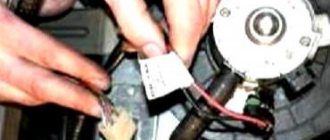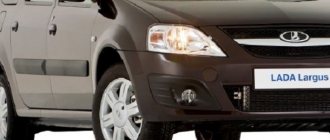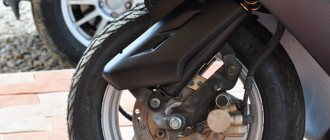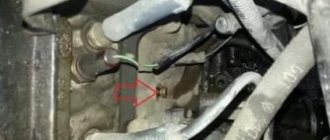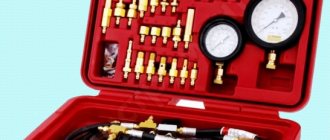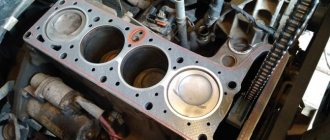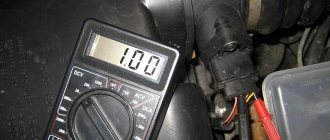Reading time: 6 minutes
One of the important aspects of a safe ride is the correct tire pressure. Car enthusiasts often do not pay special attention to such a small thing as pressure. But this is far from a trifle, and with an inappropriate wheel inflation index, not only the car, but also the passengers can suffer.
Sometimes even experienced drivers do not know exactly how many atmospheres should be in the tires of their own car. Each car has its own indicators regarding the optimal tire pressure. And they may differ on the front and rear wheels. This is explained by the fact that when the car is loaded, more load is placed on the rear tires. Therefore, the pressure in them is usually higher than in the front ones.
Inflated wheel
Each vehicle undergoes many tests before reaching auto stores. And among them there are tests for optimal tire pressure. Each individual car has its own standards regarding the amount of atmospheres in the wheel. And they are indicated by the manufacturer on the gas tank hatch or on the driver's door. It clearly states the optimal indicators for minimum and maximum vehicle load. It is these parameters that vehicle owners need to adhere to.
Features of tire inflation in winter
The adhesion spot in winter should be larger than in summer. That is why the tire pressure should be reduced. The larger the grip area, the less likely it is to have an accident on a slippery road. For the accuracy of the indicators, it is necessary to take these indicators correctly. This is done as follows:
- First you need to check that the tires are not warmed up.
- Three hours before taking measurements, you should not use the car for its intended purpose.
- Measurements must be taken on all four wheels of the vehicle.
Only if the correct conditions are met can we assume that the tire pressure in a Chevrolet Niva is determined correctly. Of course, all owners of this brand are interested in the exact air coefficient in their tires. You need to know that the Chevrolet Niva with different tires has excellent measurements, namely:
- A Chevrolet Niva with 205/75 R15 wheels has a pressure in the front wheels of 2.1/30 atm./psi. The rear tires should have the same data;
- a model with tire size 215/65 R16 has rear performance of 2.2-31 atm/psi and front performance of 2.2/31.
Service station experts recommend installing tires on a Chevrolet Niva strictly according to the season, thereby eliminating universal, all-season tires. When operating a machine in high positive or negative temperatures, the rubber composition changes its properties, thereby deteriorating the technical characteristics.
Before purchasing tires for a Chevrolet Niva yourself, get advice from specialists regarding the compatibility of tires with your car model.
ATTENTION! A completely simple way to reduce fuel consumption has been found! Don't believe me? An auto mechanic with 15 years of experience also didn’t believe it until he tried it. And now he saves 35,000 rubles a year on gasoline!
The choice of tires is a real problem for most Chevrolet Niva owners due to the fact that the “range of sizes” is limited. Driving for a long time on tires with inappropriate sizes leads to decreased vehicle control and emergency situations.
The abbreviation stands for as follows:
- wheel rim width;
- surface diameter;
- reach length;
- tire width;
- height in percent;
- diameter of the metal rim.
The higher the disc is installed on the car, the greater the risk of skidding and reduced control efficiency. At the same time, excessively low wheels also negatively affect ground clearance, lower ground clearance, and limit the vehicle’s maneuverability.
What tires can be installed instead of the factory ones?
The reasons for installing tires with other sizes may be different, for example, the driver wants to increase the speed of the car, or increase its maneuverability and weight load. It all depends on the conditions in which you will operate the car. An option to replace factory tires in the summer can be 215/75R15 tires, and for a wheel with a diameter of R16 in the winter, 215/65R16.
Usually, after indicating the size, the tire is marked with a load index and a speed index. The speed index is indicated by Latin letters, the load index is indicated by a number. For a Chevrolet Niva, you need to install a tire with the Q index, which means the maximum safe speed on such tires is no more than 160 kg. There is no point in installing a tire with a high speed index, since the car engine simply will not support it.
The load index characterizes how much weight the tire will bear when driving at maximum speed. Under normal conditions, you can install a tire with an index of 95-97, which means 690-730 kg. If the machine is used to transport cargo, then it can be supplied with index 100, this is a load of 800 kg. on rubber.
When selecting a tire, you must strictly adhere to the seat diameter. You cannot put an R16 tire on an R15 rim, or vice versa, an R15 tire on an R16 rim. In the first case, the rubber will simply dangle on the disk, and in the second case, it may burst during installation or while driving.
Review of the best summer and winter tires for the Chevrolet Niva
The most popular winter tires:
- Vredestein Wintrac Xtreme S - the tread consists of Velcro, which provides maximum traction on wet asphalt and loose snow. The maximum temperature of use is 25°C. The critical point is -35°. The average cost in online catalogs is from 8,500 rubles.
- Goodyear UltraGrip Performance Gen-1 - balanced price-quality ratio. The tire provides good traction on loose snow and ice at sub-zero temperatures. Average price from 7,000 rubles.
- Dunlop Winter Sport 5 is a soft compound rubber that is not susceptible to hardening when the temperature drops. The price of one tire is from 5,500 rubles.
- Pirelli Winter Sottozero 3 is a popular model among car enthusiasts in the CIS, including the Russian Federation. Good quality, technical specifications at an affordable price. The service life before replacement exceeds 60 - 70 thousand km. mileage The average price by region is from 5,000 rubles.
- Nokian WR D4 is an economical option for most car owners. High-quality grip, long service life, affordable price from 2900 rubles.
Summer tires for Chevrolet Niva:
- Goodyear Ecient is a high-quality tire at a premium price from a European manufacturer. The tire warms up within a few seconds, providing the widest possible contact patch with the road surface. Rubber guarantees grip, control, cornering, and a minimum percentage of skidding at medium and high speeds. Average price from 5000 rubles.
- Grip Performance is a budget option from a European brand. Better than standard tires in terms of technical characteristics, acceptable for use in urban conditions. Price from 5500 rubles.
- Hankook Ventus Prime3 K125 is also a budget model with a price starting from 6,000 rubles. Above average quality at an affordable price.
- Dunlop SP Sport MAXX RT2 is a tire with unidirectional tread, which ensures high handling and minimal vehicle roll when cornering, regardless of weather conditions and temperature conditions. Average cost from 5200 rubles.
- Dunlop SP Sport MAXX RT (size R16) - tires are similar to the previous ones, except that the tread pattern is asymmetrical. Price from 5100 rubles.
- Pirelli P7 Cinturato Blue - long service life is the main highlight of the rubber. The average service life exceeds 65,000 km before replacement. Average price from 5500 rubles.
Service station specialists strongly recommend changing tires strictly according to the seasons, and to a lesser extent using universal, all-season tires. The operating temperature range is several degrees lower than seasonal tires, resulting in reduced vehicle controllability.
Indices and tire sizes for Chevrolet Niva (4x4)
To choose the right tire you need to be able to read the indices and other symbols on the tires, namely:
- “T” - the maximum permitted speed of movement is not more than 195 km / h. “H” - up to 205 - 210 km/h. It is not recommended to exceed the speed range, as there is a high probability of shooting, cord deformation, and, as a result, an emergency;
- “Q” - load capacity index: from 85 to 490 kg;
- “ET” is the metal rim bead extension coefficient;
- “KM” - partial and full load index: no more than three passengers, cargo in the trunk up to 50 kg;
- “M+S” - full load - more than three people and over 50 kg in the trunk.
Bottom line
Today, the Chevrolet Niva is a truly reliable and high-quality car. It is able to overcome all kinds of potholes, potholes, swamps, clay and stone terrain without much harm to the entire structure. At the same time, for some reason the manufacturer forgot to equip the Shniva with a more powerful power unit, at least 105-125 hp. The presence of a more powerful engine would make this car even more attractive in the eyes of potential buyers.
The Chevrolet Niva suspension has an independent device. It is based on two wishbones located on both sides. To smooth out vertical vibrations, coil springs and shock absorbers are used. To eliminate strong rolls when cornering, anti-roll bars are used.
How the pressure sensor works, how to turn it off on a Chevrolet Niva
The main task of the controller is to monitor changes in air pressure in the tire and transmit data online to the electronic control unit. The latter compares the indicators with the programmed ones and informs the driver about a possible malfunction. Most often, this is a sound signal combined with light flickering.
Principle of operation
- A pressure measuring sensor is installed on the inside of the tire. This must be done with the wheel lowered.
- After activation, the controller measures the pressure every 3 seconds and sends the data to the ECU. Bluetooth technology is used as a means of communication.
- The electronic control unit analyzes the obtained indicators for each of the wheels and compares them with the specified parameters.
- The end result can be duplicated on a smartphone if a special application is installed on the latter.
How to disable pressure sensors
There is no such thing as deactivating a sensor for the reason that it is impossible, since the absence of equipment must be registered at the system level. In case of unauthorized deactivation of the controller, “Error” is displayed on the dashboard.
Some car owners practice physically dismantling controllers in a service station. Do not try to do this on your own, as unprofessional intervention does not guarantee full functionality of the electronic control unit.
Sensor sensitivity
- Sudden surges in pressure due to falling into a hole or road bump;
- Critical low/high pressure;
- Installation of rubber tires that are larger or smaller than the recommended standards;
- Installing a damaged tire;
- Uneven distribution of load on the axle, passengers in the vehicle interior;
- Systematic operation of the controller during lifting and lowering of the machine;
- Metal chains are installed on rubber tires.
The tire pressure of any car is not just the key to a comfortable ride. Maintaining the correct level of air in the tires of any vehicle is, first of all, the safety of the driver and passengers on the road.
Also, incorrect tire pressure can cause problems in the operation of the entire chassis and wheelbase of the vehicle. Therefore, this indicator should be monitored regularly. Next, we will consider how this should be done on a Chevrolet Niva car, and what the consequences of incorrect indicators are.
Car tire pressure monitoring
Hoses for power steering Niva Chevrolet, life
set of 3 hoses
The power steering system consists of 4 hoses. One high pressure with a valve in the middle (pump-steering machine) and 3 low pressure hoses. In the designer's fields, the radiator was completely excluded from the system, so there are only two low-pressure hoses. The pressure in the “main” hose reaches several tens of kg, but there is almost no pressure in the “secondary” hoses.
The plant, with the tenacity of maniacs, installs rough, thick-walled high-pressure hoses. Their disadvantage is that they cannot normally be compressed even with threaded clamps, especially in cold conditions. So their wet appearance is normal. The recommendation is simple, along with replacing the fluid and flushing the system - replace the Chevrolet Niva power steering hoses with modern and high-quality ones.
Since I don’t really like stepping on rakes, I consulted with a hydraulic engineer on this topic. He “gave me” a Taiwanese hose manufacturer. The working pressure of the hoses is 250PSI (approximately 17 atmospheres). For general technical development, let me remind you that PSI is pounds per square inch. The hoses are two-layer.
The internal part is MBS (oil and petrol resistant), the external part maintains external temperatures. Based on many years of installation experience on different machines, I can say the following. No cracks have ever been noticed in any climate. The most I have noticed is fading after a couple of years of use in hot climates, but as you know, this does not affect the speed.
Read news about the new Niva
- FROST car air conditioners // Online store // Prices // Air conditioners for cars Lada VAZ, VolksWagen Polo, Daewoo Matiz
- Low engine oil pressure causes and solutions
- The modernized Lada Niva Legend (4x4) 2021 was shown on the Internet
- No longer Chevrolet: Lada Niva returns - Autoreview
- Lada 4×4 Bronto - sales stopped, new details » Lada.Online - all the most interesting and useful about LADA cars
- Description of the instrument panel Lada 4×4 (VAZ 2121, 2131) » Lada.Online - all the most interesting and useful about LADA cars
- What will the new Niva 2024 be like, new details » Lada.Online - all the most interesting and useful about LADA cars
- Buy Chevrolet Niva 2019-2021, models, price | Vita-Auto, Moscow
Measuring methods
It is impossible to determine the amount of air in tires without special instruments. Outwardly, it turns out to notice only some deformations, the cause of which was incorrect pressure. As a result, some depression may appear on the rubber itself and the tread pattern may change.
You can measure tire pressure on a Chevrolet Niva only using pressure gauges. There are two types of such devices:
- mechanical (switch);
- electronic.
Electronic pressure gauge for cars
The percentage of error for mechanical pressure gauges is higher, but not significant. In everyday life, they can be used with the same success as their electronic counterparts. Electric pressure gauges provide the most accurate results. The error indicator in this case is no more than 0.05 bar. Today this is the most accurate device for measuring tire pressure not only on Niva, but also on other cars.
It should also be noted that in winter the tire pressure level can be more or less accurately measured only with an electronic pressure gauge.
Instruments for checking the degree of pumping
For cars such as the Chevrolet Niva, maintaining this parameter is especially important. The center of gravity of this car is high, and the car cannot be called stable, especially during emergency maneuvers. It is impossible to measure the degree of air compression in a tire without special measuring instruments.
Pressure gauges are used for these purposes. They are divided into two categories that differ structurally:
- Mechanical pressure gauge. A device for measuring tire pressure, having a mechanical drive and a dial indicator. Has a significant degree of error, long service life, does not require a power source.
- Electronic pressure gauge. Electronic type device with a screen for displaying measurement data. It is powered by an internal power source; when used correctly, the error tends to zero.
Important: The error of devices of the first type is greater in winter than in summer due to temperature deformations of mechanical parts. In cold weather, it is recommended to use only to get to the garage or service station. The disadvantage of electronic pressure gauges is that the battery can run out at the most inopportune moment.
Features of pumping in winter
Since in winter the tire’s grip patch should be slightly larger than in summer, you should slightly reduce the pressure in the wheels of your Niva 2121 or 21214. This is due to the fact that the road surface is most often covered with ice. The larger the adhesion area, the lower the risk of an accident. Under the weight of the car, the tire “sags”, the tread opens up more, which ensures tight traction of the wheel even with bare ice and at high speed.
Standard tire pressure for Niva 2121 and 21214
Why is it necessary to control?
Reduced or increased air content leads to a change in the contact surface of the tires with the road surface. This leads to various consequences.
For high blood pressure:
- road grip decreases
- road stability decreases
- tire tread wears off unevenly, more in the middle
- the shock-absorbing properties of the wheel are reduced
- the risk of damaging the tires when falling into a hole increases
- braking distance increases
Relieving pressure correctly
In order for the readings to be accurate, you need to remove the pressure correctly. This should be done this way:
- tires must be unheated;
- for the last 3 hours before measurement, the car should be at rest or drive no more than 1.5 kilometers;
- Measurements must be taken on all four wheels and the spare wheel.
Only in this case can the readings from the pressure gauge be considered correct.
Table of values for the required tire pressure level for the Chevrolet Niva:
The pressure standards for Niva wheels 2121 or 21214 must be indicated on a special metal plate. As a rule, it is attached to the door on the driver's seat side. If for some reason there is none, you can look at the data online. But in this case, it is better to take into account the readings only approximately.
You should also pay attention to the fact that the amount of air in the rear tires should be about 0.3-0.5 bar more. This is due to the fact that the load on the rear axle of the wheel is always greater than on the front.
Checking car tire pressure
Measuring devices
A pressure gauge is used to measure tire pressure.
There are three types of pressure gauges:
The dial pressure gauge is most often used, as it is the most reliable and cheapest. It works on the basis of a special spring. The same spring is the “Achilles heel” of the pressure gauge; if the device is hit or dropped, it can break.
A mechanical pressure gauge is more reliable. It is based on a cylindrical spring. However, this pressure gauge shows the greatest measurement errors.
An electronic pressure gauge has the greatest accuracy. True, very cheap devices lack this quality. Like any electronics, it is less reliable compared to its mechanical counterparts.
Important . The check is carried out on cold wheels. This means that the machine must be left at rest for at least 3 hours.
Consequences of incorrect pressure
In addition, if the pressure is incorrect, the chassis and wheelbase of the Niva 2121 or 21214 are destroyed. The following negative factors may also arise:
- fuel consumption will increase significantly (on average by 1.5-2 liters);
- tires will become deformed;
- There will be a possibility that the tire will burst while driving, which could lead to an accident.
All these negative factors can be avoided if you timely measure the pressure in Niva 21214 or 2121. By the way, this applies to any vehicle.
Your safety on the road while driving depends on the pressure in the tires of your Niva 2121. Therefore, you should not neglect such checks - they need to be carried out regularly (on your own or at a service station).
In addition, in addition to safety while driving, if tire pressure standards are not observed, the vehicle's chassis and wheelbase wear out much faster.
Let's continue the topic of winter tires and their proper use. Of course, you know that in order for your tires to last as long as possible, you need to monitor the pressure. Moreover, in winter and summer you need to pump differently. Why? Let's figure it out now. Moreover, comfort, safety, speed of tire wear and much more depend on the degree of tire inflation. In winter, we are primarily interested in safety - that’s what we’ll talk about. With the correct tire pressure we can increase safety on winter roads. The winter road is ten times more dangerous than the summer road.
I won’t talk about summer, there are some nuances to inflating tires. Let's consider the winter period.
A winter tire is very different from a summer tire; it is completely cut up with lamellas - Velcro, the task of which is to “open up” under the weight of the car and stick to ice and icy surfaces. Even a studded tire will have sipes.
That is why, in order to increase the contact patch with ice, the wheels should be inflated a little less than usual. Flat tires flatten more under the weight of the car, the contact patch is larger, the Velcro “opens” more and the tire sticks perfectly to a hard surface. This concerns ice and icy asphalt.
Likewise, a flat tire digs loose snow very well. By analogy with how UAZ manufacturers “poison” tires on off-road terrain - they lower them to 1 atmosphere and even lower (depending on the strength of the tire sidewall and its softness), the contact patch with dirt increases and cross-country ability increases.
However, let's consider this option - the tire is studded and very soft. You pumped it up a little more lightly, in the snow and crust - just gorgeous. And suddenly she began to slip on the ice. What's happened? There are situations (this depends on the quality of the studs and the composition of the rubber mixture) when the studs on a soft tire are pressed into the tire. And if you also inflated it less, then it turns out that the studs are always inside the tire, only the outer ones cling a little, while the central ones are almost always inside. Therefore, you need to keep this nuance in mind.
However, the general trend is still the same: in winter we pump the tires weaker. There are pressure tables on the Internet for each brand of car (both for winter and summer), you can find out for yours. I’ll tell you about the Chevrolet Niva. The photo shows my all-season mud bike (more complete review):
In winter, on a Shevik, I always pump 1.7 on all wheels; when there is heavy ice on the roads, I lower it to 1.5. My Velcro is soft and sticks to the ice quite well, but when I pull it down, it generally holds just fine.
I won’t touch on the question of “tires or Velcro” here either, and everyone understands that studs are preferable, but still, first of all, the choice depends on the conditions and places of use. A city with a population of one million, where in winter there is almost always bare asphalt - the linden tree will rule. A small northern town, where the roads are swept away and there is ice everywhere - spikes rule.
Monitor not only your pressure :-), but also the pressure in the wheels of your car, your life and the lives of your passengers and other road users depend on it. Don't drive recklessly on the winter road, it's not worth it. You can always drive in the summer if you don’t have the strength to drive normally)) Well, buy normal winter tires if you don’t already have one and are hoping for the chance. Like, I’ll drive one more winter season on these inferior tires, and then I’ll buy normal ones. “Later” may not come. Live here and now. Well, good luck on the roads, no problem, as they say.
One of the important aspects of a safe ride is the correct tire pressure. Car enthusiasts often do not pay special attention to such a small thing as pressure. But this is far from a trifle, and with an inappropriate wheel inflation index, not only the car, but also the passengers can suffer.
Sometimes even experienced drivers do not know exactly how many atmospheres should be in the tires of their own car. Each car has its own indicators regarding the optimal tire pressure. And they may differ on the front and rear wheels. This is explained by the fact that when the car is loaded, more load is placed on the rear tires. Therefore, the pressure in them is usually higher than in the front ones.
Inflated wheel
Each vehicle undergoes many tests before reaching auto stores. And among them there are tests for optimal tire pressure. Each individual car has its own standards regarding the amount of atmospheres in the wheel. And they are indicated by the manufacturer on the gas tank hatch or on the driver's door. It clearly states the optimal indicators for minimum and maximum vehicle load. It is these parameters that vehicle owners need to adhere to.
Those drivers who are fans of Niva should pay special attention to pressure indicators.
This is because the car has a high center of gravity. It is difficult to control in an emergency situation, such as a sharp turn, as it is not very stable. Therefore, it is necessary to monitor and check the amount of atmosphere in a tire once a week. For such measurements there are special pressure gauges, which are:
- mechanical;
- electronic;
- rack and pinion
On a note.
Mechanical models are considered more durable, but often have measurement errors.
They don't need a power source, which is another plus. Electronic devices have virtually no errors, but are dependent on batteries that can run out at the wrong time. Rack and pinion pressure gauges are considered very inconvenient to use, but they do not allow for inaccuracies. Few people use them because they are very fragile.
The pressure in the Chevrolet Niva wheels on the front and rear axles is no different. For example, the optimal indicators correspond to 2.1 atmospheres, and at maximum load they increase to 3.0. However, these standards may vary depending on the radius of the wheel. In winter, you can reduce the pressure slightly, by about 0.2 bar. This helps the hard rubber handle the road and increase the contact patch area. In summer, atmospheric indicators should be kept within the recommendations
Rearranging wheels taking into account the spare wheel
If you include a spare wheel in rotation, you can achieve an increase in the wear threshold of the entire tire set by an average of 20%. But be careful and do not use the spare tire if it is in perfect condition and the four wheels are already bald. The reason is that there is a difference in radii, which can cause damage to the transmission.
Rearranging wheels on a car including a spare tire
Thus, it is not difficult to rotate the wheels; the main thing is to understand why this is necessary and how to perform this rotation procedure. Car enthusiasts claim that such routine actions will lead to results - an increase in the service life of tires.
When independently changing the location of the wheels on a car, you must remember that the scheme for rearranging them depends on.
Why do you need to rotate wheels?
For every car, regardless of whether it is front-wheel drive, rear-wheel drive or all-wheel drive, the tires of the wheels located on the drive axle wear out more intensively than on the free one.
Ensuring uniform wear of their treads is possible only by periodically rotating the wheels of the car.
For most cars, this procedure is recommended to be performed every 10 thousand kilometers.
Chevrolet Spark tire pressure indicators
Many people consider the Chevrolet Spark to be a toy car, but this is not at all true. It doesn’t have much power, but it can quickly dodge at a traffic light. The recommended tire size for it is from R13 to R15. In summer, you need to inflate all wheels to 2.2 Bar, and in winter to 2.1 Bar. If you do not adhere to such indicators, then if the car is under-inflated, it will be difficult to control, and it will skid when turning, especially in winter.
When the atmospheric indicators are different in all tires, then this is the worst thing that can happen to the wheels.
In such a situation, underinflated tires will literally drive sideways, and fuel consumption will increase significantly. When the number of atmospheres does not match the recommended standards, this can lead to:
- tread wear;
- premature tire wear;
- deterioration of controllability;
- failure of the car's chassis;
- excessive fuel consumption.
So it’s better to adhere to these standards than to spend money on new spare parts and tires.
It is necessary to check the pressure only when the tires are cold, otherwise the pressure gauge will show an incorrect result.
The machine must be at rest for at least three hours for the pressure readings to become clear. As the tire heats up, the volume of air inside it also increases, so for accurate readings you need to take measurements on cold tires.
Rules for using differential
These include:
- Switching the transfer case should only be done when the car is not moving.
- You can also engage the differential while the vehicle is moving.
- You can switch to a lower gear while the car is moving.
- To ensure long-term and uninterrupted operation of the differential, it is necessary to periodically turn it on, especially in winter. This should be done once every 7 days.
Shift lever location
In the interior of the Niva Chevrolet there are two levers between the front seats
. Using one of them you can change gears in the gearbox, and using the other you can control the transfer case.
Differential shift lever
The transfer case is based on a gearbox consisting of two stages
. The control lever comes out of it into the cabin. He can move forward or backward. At the same time, it switches on/off downshift. If the lever is moved left or right, it can turn the differential lock on/off.
Gear shift and transfer case diagram
Downshift: what does it give?
The main component of the transfer case is the reduction gear
. If the control lever is in the rear position, the number of transfer cases decreases and amounts to 1.2
.
When the lever is in the forward position, the gear ratio increases. It will already be 2.1
. When the lever is in the neutral position, the gear ratio is equal to .
The differential is an integral part of the all-wheel drive mechanism in any car. It is recommended to use it only when the car is moving off-road.
Tire pressure in Chevrolet Aveo
In the case of a Chevrolet Aveo, tire pressure varies significantly depending on the tire size. So, for example, in wheels R13-R14 the number of atmospheres should be 2.1 Bar. And with increased load it increases to 3.0 Bar. But tires of size R15-R16 require an increase in indicators to 2.5 Bar at minimum load, and up to 3.5 Bar at maximum.
In the summer, hot weather causes the air to heat up and tire pressure to increase slightly. Therefore, you can underinflate the wheels by about 0.2 Bar. Before every long trip, it is worth checking the indicators in all four wheels and in the spare tire.
If you don’t want to fool your head with constant measurements, then you can simply buy a pressure control system that will do everything automatically.
This device measures both the pressure and temperature of the air inside the tire. All results are displayed on the electronic panel. And if the sensor notices a violation of the amount of atmospheres in any tire, the system notifies the owner about this with a sound or light signal.
If you don’t want to spend a lot of money on such a system, you can purchase mechanical controllers that screw onto a nipple. As the pressure drops, the color of the cap changes. This device does not notify of violations of standards. Only visual control is possible behind it.
Pressure meter
Table of standards for various tires
| Tire type | Front, atm | Rear, atm |
| 205/70 R15 | 2.1 | 2.1 |
| 205/75 R15 | 2.1 | 2.1 |
| 215/65 R16 | 2.2 | 2.2 |
Attention!
The pressure in the rear tires should be approximately 0.3 - 0.5 bar higher if you plan to carry a heavy load.
In winter, you can slightly reduce the amount of air to increase the tire contact area with the road.
So, dear car enthusiasts, do not forget to regularly check the tire pressure, because the safety of you and your loved ones depends on it.
Correct pressure in a Chevrolet Cruze
Cruze cars may have tires of size 15, 16, or 17. The optimal pressure should be 2.2 bar. These parameters apply to both the front and rear axle wheels. The table on the car body indicates that the minimum fuel consumption is achieved at 2.7 Bar. On the one hand, this is good, but on the other hand, there will be an increased load on the suspension and the middle part of the tread, which will wear out intensively.
On a note.
These parameters are suitable for fast movement on the highway, but for ordinary city roads it is better to stick to 2.2 bar. Therefore, it is not worth maintaining high blood pressure unnecessarily for a long time. This may still be justified when the machine is heavily loaded. Then increasing the number of atmospheres is simply necessary, since the tires are under heavy load.
Replacing grease in wheel bearings
When repairing the Chevrolet Niva suspension, the lubricant in the bearings should be changed at the intervals indicated in the service manual. If there is little lubricant or it is dirty, the bearings will wear out quickly. To work, you will need a pair of 13mm wrenches, a wrench for wheel bolts, a torque wrench, a hammer, a screwdriver, Litol-24 and a container for washing the elements.
Lubrication process
First you need to remove the wheel and brake pads. The caliper is dismantled without disconnecting the hydraulic hoses. Just move it to the side and hang it on a wire so as not to load the hose. Pull the rubber holder out of the hose bracket.
Replace the grease in the bearings at the intervals specified in the service book. If the lubricant is insufficient or contaminated, the bearings will quickly fail. To replace, you will need 13" keys (two), a torque wrench, a wrench for wheel nuts, pliers, a screwdriver, a hammer, clean Litol-24 lubricant, and a container for washing parts. Remove the wheel and brake pads.
Next, you need to loosen the pin nut of the outer joint of the side link and unscrew it. Install the puller and press out the steering joint pin that is held in the steering arm boss. Unscrew the three nuts of the bolts that hold the ball joint and the support on the arms, and unscrew the hub nut. Remove the bolts and remove the steering knuckle and joint assembly. Using a suitable bushing, press the hub out of the bearing races.
Use a screwdriver to pull the oil seal out of the hub, but keep in mind that it will have to be replaced after this. Pull out the spacer and inner races of the bearing, and then wash all the elements with kerosene and fill the internal cavity with lubricant. Also apply Litol to the inner and outer rings of the bearings.
Insert the inner and spacer rings into the steering knuckle, and then press the oil seal into the steering knuckle socket. Reinstall everything in the reverse order and adjust the wheel bearing clearance according to the instructions described above.
Pressure indicators "Lacetti" Hatchback
All experienced motorists recommend following the manufacturer's recommendations regarding optimal tire pressure. If the wheels on the car are factory, then there is no need to deviate from the provided standards. But if the car was refitted with other tires of a different size, then the indicators may vary slightly. It all depends on the recommendations of the tire manufacturers.
If no more than four people travel in a car, then the number of atmospheres should be 2.1 bar. And when the car is fully loaded, you need to pump it up to 2.4 Bar. Such brands of cars are often produced with a built-in pressure control system. Therefore, it is much easier to follow the standards, since all measurements are taken automatically.
Consequences of incorrect tire pressure
Adjusting the Chevrolet Niva steering wheel position
The car is equipped with a tilt-adjustable steering column. Before driving, adjust the position of the steering wheel so that it is convenient to drive the car and at the same time so that the instruments in the combination are clearly visible.
We recommend adjusting the position of the steering wheel after you have installed the seat in a comfortable position (see “Adjusting the position of the front seats”).
Adjust the position of the steering wheel only when the vehicle is stationary. If you try to make adjustments while driving and you do not securely position the steering column and it suddenly moves, you may lose control of the vehicle.
To select the optimal steering wheel position, lower the locking handle down.
. and after installing the steering wheel in the desired position, lock the steering column by moving the handle to its highest (initial) position.
Video about “Adjusting the steering wheel position” for Chevrolet Niva
https://youtube.com/watch?v=2dXGY-0CUFg
https://youtube.com/watch?v=aZOKMAgyJOg
Source
Chevrolet Orlando tire pressure
This brand of car has a fairly large size and weight, so the atmosphere indicators in tires are higher than those of the previous models under consideration. The manufacturer recommends maintaining a value of 2.4 Bar in all four wheels. And when the load increases, raise it to 2.7 Bar.
But many car enthusiasts complain that when the wheels are inflated this way, the car drives harshly and a rattling sound is heard inside the cabin.
Therefore, on forums you can often find advice from drivers who recommend pumping the wheels to just 2.0 bar. With such indicators, the car drives smoother and there is no discomfort while driving. Convenience may be higher, but tire wear still increases. And fuel consumption will increase slightly.
It is necessary to monitor the pressure in your tires regularly. Failure to comply with the standards specified by the car manufacturer can affect not only the wear of car parts, but also the safety of the driver and his passengers. You need to be especially careful when choosing a pressure gauge. It is better to purchase a more expensive option with a high accuracy class than to later suffer from incorrect readings from a cheap model.
